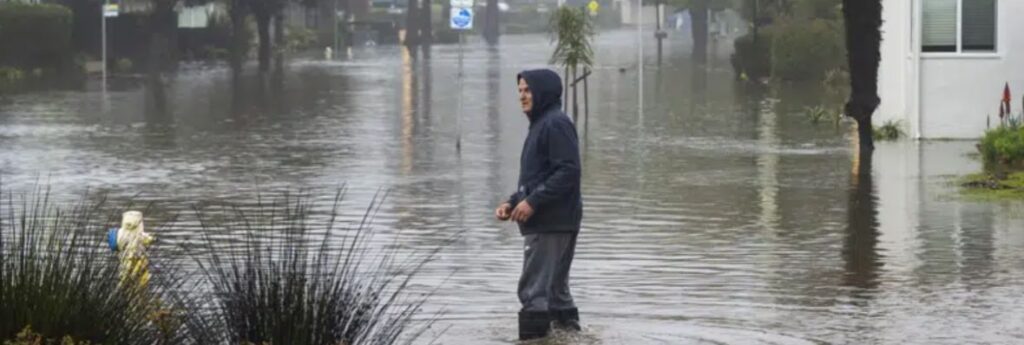Rain-weary Californians grappled with flooding and mudslides Monday as the latest in a series of powerful storms walloped the state, prompting widespread evacuations, toppling trees, and frustrating motorists who hit roadblocks caused by fallen debris.
Tens of thousands of people remained without power, and some schools closed for the day. The number of deaths related to the storms climbed from 12 to 14 on Monday, state officials said.
An evacuation order for the entire community of Montecito in the central part of the sate and surrounding canyons scarred by recent wildfires came on the fifth anniversary of a mudslide that killed 23 people and destroyed more than 100 homes in the coastal enclave.
The National Weather Service reported that at least 20 cm of rain fell over 12 hours, with several more inches predicted before the latest storm system moves through an area where roads wind along wooded hillsides studded with large houses. Upscale Montecito is squeezed between mountains and the Pacific and is home to celebrities including Oprah Winfrey, Rob Lowe and Harry and Meghan, the Duke and Duchess of Sussex.
Santa Barbara County Sheriff Bill Brown said the decision to evacuate nearly 10,000 people was “based on the continuing high rate of rainfall with no indication that that is going to change before nightfall.” Creeks were overflowing, and many roads were flooded, he said.
Northbound lanes of US 101, a key coastal route, were closed, along with several other highways and local roads.
A large, muddy slide blocked both lanes of southbound Highway 17, a key but windy route into Santa Cruz from the San Francisco Bay Area. Vehicles were turned back at the summit as crews arrived to clean up.
Nicole Martin, third-generation owner of the Fern River Resort in Felton, said Monday that her clients sipped coffee, sat on cabin porches amid towering redwood trees, and were “enjoying the show” as picnic tables and other debris floated down the swollen San Lorenzo. The river is usually about 18 m. below the cabins, Martin said, but it crept up to 12 4 m. from the cabins.
In Northern California, several districts closed schools while the California Highway Patrol shared video of large boulders skidding down hillsides to block state roads.
More than 35,000 customers remained without power in Sacramento, down from more than 350,000 a day earlier after gusts of 97 kph knocked majestic trees into power lines, according to the Sacramento Municipal Utility District.
The National Weather Service warned of a “relentless parade of atmospheric rivers” – long plumes of moisture stretching out into the Pacific that can drop staggering amounts of rain and snow. The precipitation expected over the next couple of days comes after storms last week knocked out power to thousands, flooded streets, and battered the coastline.
President Joe Biden issued an emergency declaration Monday to support storm response and relief efforts in more than a dozen counties, including Sacramento, Santa Cruz and Los Angeles.
Gov. Gavin Newsom said on Sunday that 12 people died as a result of violent weather during the past 10 days, and he warned that this week’s storms could be even more dangerous and urged people to stay home.
The first of the newest, heavier storms prompted the weather service to issue a flood watch for a large portion of Northern and Central California, with 15 to 30 cm. of rain expected through Wednesday in the already saturated Sacramento-area foothills.
In the Los Angeles area, there was potential for as much as 20 cm. of rain in foothill areas late Monday and Tuesday. High surf was also expected on west-facing beaches.
Since Dec. 26, San Francisco received more than 25 cm. of rain, while Mammoth Mountain, a popular ski area in the Eastern Sierra Nevada, got nearly 3 m. of snow.
The storms won’t be enough to officially end California’s drought, but they have helped.
Daniel Swain, a climate scientist at the University of California, Los Angeles, says his “best guess” if for the rain to break after Jan. 18.

